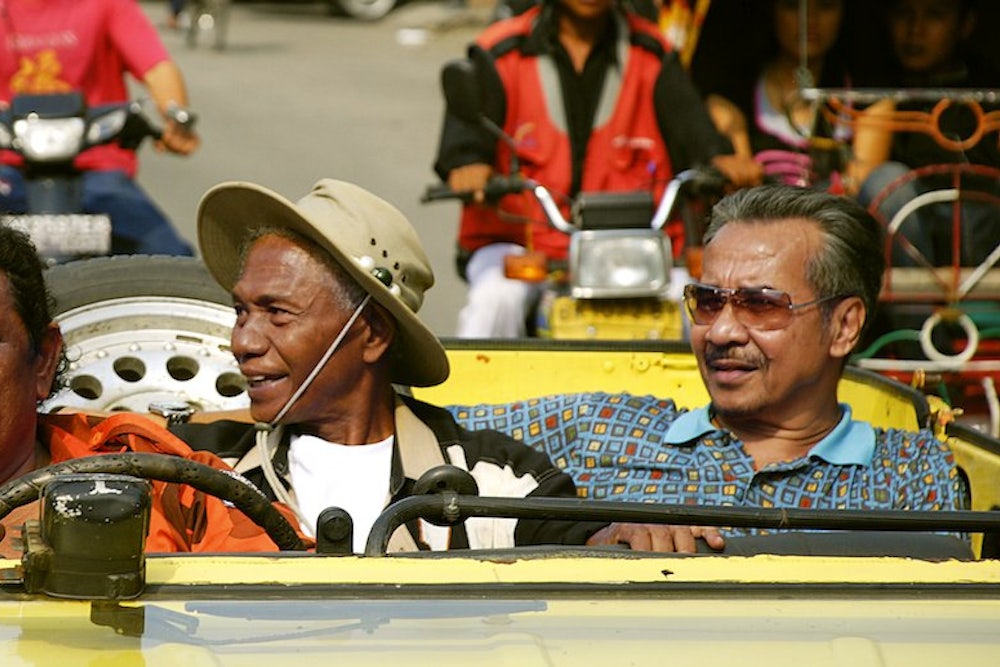There is a reason films about genocide tend to fixate on the victims, and it is not just because this can feel like the morally responsible tack: It is also that victims tend to be the most outwardly haunted, the clearest road to pathos. But Joshua Oppenheimer’s film The Act of Killing, about the mass slaughter of Indonesian communists and ethnic Chinese in the mid-’60s, manages to enter the complicated brains of the perpetrators, to disarm their egos and expose the magical thinking of murderers forced to justify their savageness to themselves. As a result The Act of Killing is perhaps the strangest, most disturbing film about genocide ever made.
“Killing is a quintessentially human activity,” director Joshua Oppenheimer told me recently. It is also, in Oppenheimer’s hands, garishly beautiful. His film opens with a row of dancers processing out of a seafood restaurant shaped like a giant fish. The scene is all hallucinatory colors and tinkling music. Gradually we learn that the two protagonists, former death-squad commander Anwar Congo and his sidekick Herman, have volunteered to dramatize the assorted ways in which they slaughtered people during the genocide, aided by make-up artists and elaborate costuming.
Better characters could hardly have been invented: Anwar is thin and angular, his long limbs always bouncing friskily, his gray hair framing a playful face. Herman is fat and slack-jawed and inexplicably dressed in drag throughout most of his performance. (Anwar chose his costumes, Oppenheimer explains.) They make a magnetic pair, perfect foils for each other, at once cocky and desperate. “When I met Herman, he came strutting down the street in a tank top and long wild hair and he looked like a real thug, and I remember being kind of frightened,” Oppenheimer recalled. But Anwar is the film's brutally conflicted moral center.
Oppenheimer, who worked on The Act of Killing for nearly a decade, first set out to make a documentary about victims of the Indonesian genocide. He encountered Anwar when he was interviewing hundreds of victims and perpetrators as part of his research. Members of the latter group, he noted, were prone to launching into boastful demonstrations of how they killed their victims, gleefully recounting their butchery. Congo was Oppenheimer’s forty-first interview. “I didn’t like him immediately,” Oppenheimer said. “But I lingered on him. I think it’s not charisma exactly—when he’s trying to be charismatic, that material was actually sort of hollow and not useful. It’s more of an openness. The doubt is all over his face from the very beginning.”
And so the focus of the project began to shift. On their first day of filming together, Congo showed Oppenheimer how he used to kill his victims by wringing their necks with wire, one end tied to a pole. Afterward, he danced a sprightly cha-cha mere feet away from the spot where he had just simulated an execution. In the movie it is a particularly chilling scene: Congo has gamely brought along a friend to play the part of his victim, and the enthusiasm of his reenactment gives it a terrible charm. Afterward, Oppenheimer recalls, he dropped Congo off at home; then he and his production manager broke down in tears in the car. “I started to intuit that perhaps the boasting wasn’t a lack of conscience but the opposite,” Oppenheimer said. “And because it is terrifying, it serves to keep everybody else in the society too afraid to challenge that story.”
Hollywood looms large as a world of glamorous villains and slinky evildoing. “Film stars only cry for a moment,” Herman says to a young relative who has been recruited to act in a violent scene and is then unable to stop sobbing. But garroting and stabbing are not what Anwar has drawn from Hollywood; he talks about leaving an Elvis Presley movie, dancing intoxicated out of the theater and killing happily. It’s less the violence of Hollywood that seduces him than its showmanship, the infinite possibilities for self-creation.
The decision to tell the story from the perspective of the killers made for an uncomfortable filmmaking experience. At one point, Herman and a troupe of thugs move from shopkeeper to shopkeeper in an outdoor market, demanding money with each one. The close-up shots of shopkeepers’ faces—the tight distress, the sense of pained inevitability—are particularly hard to watch. Oppenheimer himself was so disturbed that he stayed behind after each extortion under the guise of having the shopkeepers sign a release form, then quietly paid each vendor back. “In hindsight I’m not sure it was a good idea,” Oppenheimer admitted. “It could have been dangerous for us.” In another scene, a man confesses that his own stepfather was killed in the genocide, then goes on to participate in a campy reenactment in which he plays the part of a victim. It made Oppenheimer feel ill; he had no idea before editing the footage that an actual victim was among the actors. His cinematographer, who didn’t speak Indonesian, recorded the story without knowing what it was about.
In the end, Anwar Congo is not quite likable, but the shame behind his swagger is crushing. His antics make for a thin, pitiful veneer. Today, Oppenheimer and Congo still Skype every month; they discuss Anwar’s health and his grandchildren, the assorted public responses to the film. “The Star Wars mentality where we divide the world into good guys and bad guys is what allows us to withdraw from those parts of ourselves,” Oppenheimer said. And so the final scene of the movie is not a stylized dramatization but a stretch of raw footage in which Anwar, after reenacting one of his murders, repeatedly wretches. Moments after a smoky, noirish torture scene that recalls many a gangster movie, Anwar is alone on a dark roof, clutching his stomach. “That allowed me to see what has become the central message of the film: that somehow everybody already knows everything,” Oppenheimer told me. “Everybody knows what is wrong.”
Follow @lbennett.
